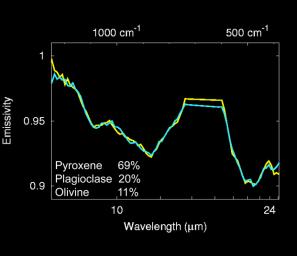Recipe for ‘Bounce’ Rock
Caption:
The mineralogy of "Bounce" rock was determined by fitting spectra from a library of laboratory minerals to spectra of Bounce taken by the Mars Exploration Rover Opportunity's miniature thermal emission spectrometer. Bounce is made-up of 69 percent pyroxene, 20 percent plagioclase, and 11 percent olivine. The pyroxene minerals are primarily calcium-rich varieties, with smaller amounts of a class of minerals called orthopyroxenes. The composition of Bounce is significantly different from that of typical martian basalts seen over much of the surface from orbit by the Mars Global Surveyor thermal emission spectrometer. The rock's composition is, however, similar to that of meteorites thought to have come from Mars. No detectable hematite was found in Bounce.
Cataloging Keywords:
| Name |
Value |
Additional Values |
| Target |
Mars |
|
| System |
|
|
| Target Type |
Planet |
|
| Mission |
Mars Exploration Rover (MER) |
Mars Global Surveyor (MGS) |
| Instrument Host |
Opportunity (MER-B) |
Mars Global Surveyor |
| Host Type |
Rover |
Orbiter |
| Instrument |
Miniature Thermal Emission Spectrometer (Mini-TES) |
Thermal Emission Spectrometer (TES) |
| Detector |
|
|
| Extra Keywords |
Color, Thermal |
| Acquisition Date |
|
| Release Date |
2004-04-14 |
| Date in Caption |
|
|
| Image Credit |
NASA/JPL/Cornell/ASU |
| Source |
photojournal.jpl.nasa.gov/catalog/PIA05758 |
| Identifier |
PIA05758 |

